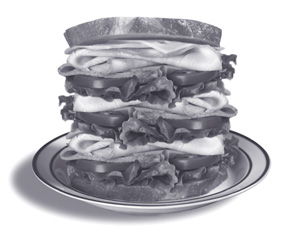IN THIS ISSUE
Researchers Find Link Between Obesity and Diabetes in Children
IRS Allows Tax Deduction for Obesity Treatment
Physical Fitness Level: Best Predictor of Death in Men
Treatment for Lipodystrophy Reveals New Workings of Leptin
Doctors Advised to Screen for "Pre-diabetes"
Public-Private Partnership Seeks To Improve the Nation's Health
Health Information for Older Adults
New WIN Publication
Materials From Other Organizations
Meeting Notes
WIN
NIDDK
WIN Notes is
produced by the
Weight-control
Information Network
(WIN). Questions or
comments should be
referred to the editor,
Weight-control
Information Network
1 WIN WAY
BETHESDA, MD
20892-3665
TEL (202) 828-1025
FAX (202) 828-1028
Presto! Portion Sizes Grow Before Our Eyes

Do you enjoy nibbling on a muffin from a well-stocked pastry case while you sip your morning coffee? The next time you do, take a close look at this common baked good. Today’s nibbles look like yesterday’s mouthfuls. Muffins sold in corner coffee shops, grocery stores, and vending machines are larger than those sold in the past, and are more than three times the size of one standard portion.
The standard portion size for muffins and other foods comes from the U.S. Department of Agriculture (USDA) Food Guide Pyramid, the eating plan that the USDA recommends Americans follow. The Food and Drug Administration (FDA) also uses standard portion sizes for its Nutrition Facts panels found on food labels, although these differ from USDA standards for many foods.
In a study investigating the increase in portion sizes and their link to the obesity epidemic in the U.S., researchers Lisa R. Young and Marion Nestle from New York University found that enlarged muffins were just the tip of the iceberg. Typical portions of pasta exceeded USDA standards by 480 percent, and cookies were more than seven times the size of one standard portion.
Young and Nestle gathered food samples from the most popular fast-food, family-type, and take-out restaurants. For foods sold in stores and other outlets, they gathered information from food package labels or directly from food manufacturers. They found that people are eating huge helpings of foods as single portions.This was not always the case. Young and Nestle took a look back through history to determine when portion sizes started to grow. They read old cookbooks, food industry trade publications, marketing and advertising materials, menus, guides to fast food, and food composition tables. They even found that auto manufacturers used to install smaller drink holders in cars and muffin pans used to bake smaller muffins. Young and Nestle determined that “portion sizes began to grow in the 1970s, rose sharply in the 1980s, and have continued in parallel with increasing body weights.”
Historical research revealed that foods such as beer and chocolate came onto the market in just one size—a size as small or smaller than the smallest size available today. In fast food restaurants, today’s burgers, fries, and sodas are two to five times larger than original sizes. In the 1950s, McDonalds served only one size order of french fries—it was equal to today’s small.
The growth in portion sizes is also a matter of very recent history. Today’s “Large” order of McDonalds’ fries weighs the same as 1998’s “Supersize,” and between 1998 and 2001, the “Supersize” got even bigger—it is now an ounce larger.
Fast food outlets and other venues use larger “value” sizes as selling points, using signs or having staff wear pins as point-of-purchase marketing tools. Such marketing tactics only seem to be working in the U.S. Portion sizes sold at European branches of fast food outlets are smaller than those sold in the U.S. For example, the “Extra Large” soda in London, Rome, and Dublin, is equal to the U.S. “Large.”
With this mountain of collected data, the authors hope to fuel the fires of change. They point out the need to pay attention to portion sizes when working toward weight management goals. They call for unification of Government standard sizes so the public can better understand them. Finally, the authors urge public health efforts to focus on educating the American public about the link between portion size, calorie intake, and weight gain.
The full report appears in the February 2002 American Journal of Public Health and can be accessed at www.ajph.org. s